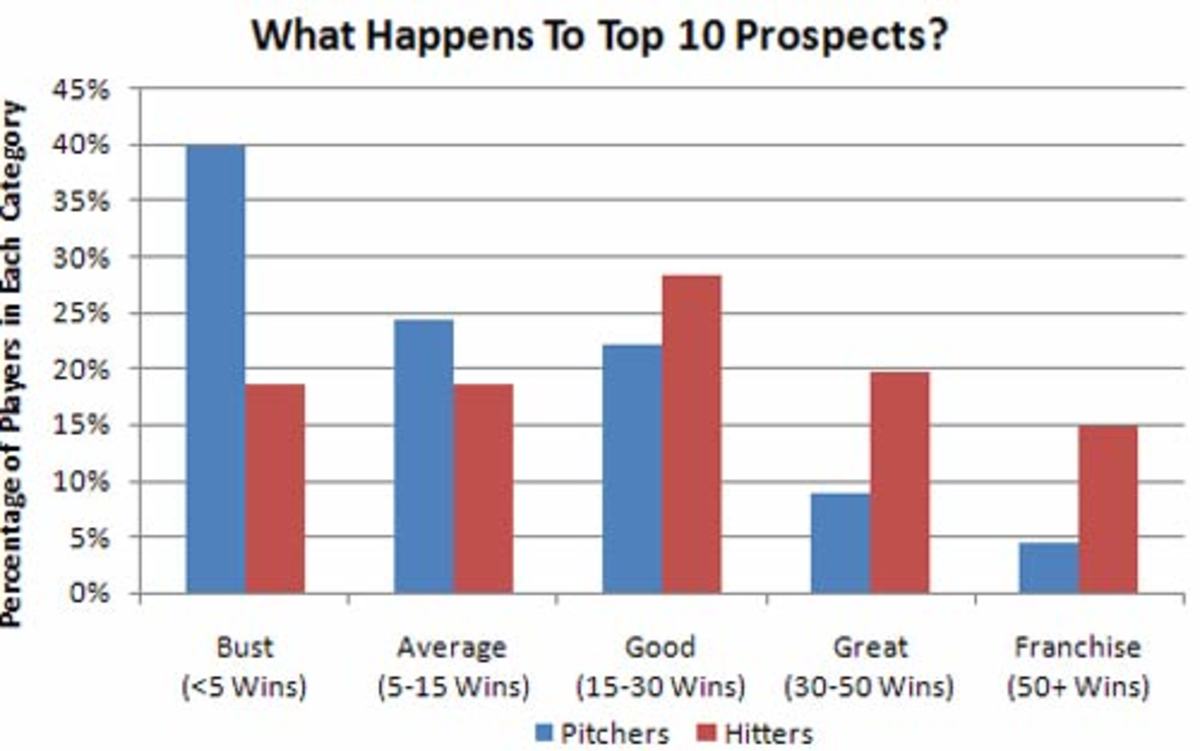How often do the game's top prospects turn into gold?
Recently, Baseball America came out with its list of the Top 100 Prospects for 2010, to much fanfare. BA's rankings are among the most respected in the game, because the selections are made by talking to a variety of general managers, scouts, farm directors and other baseball insiders. This year it was no surprise that Atlanta's Jason Heyward and Washington's Stephen Strasburg were named the top two prospects in the game.
As a fan, you're probably thrilled to see one of your team's players among the top 10 prospects going into the season. You would expect these players to be the stars of tomorrow. However, seasoned fans realize that predicting the future is tough, and that no prospect is a sure star. History is littered with can't-miss prospects who did miss. So, what can we really expect from Baseball America's Top 10 prospects?
Looking back at BA's top prospects from 1990 through 2006, we can examine how these players panned out. Using Sean Smith's Wins Above Replacement (WAR) data, we can track approximately how many wins these prospects contributed to their teams over the course of their careers.
I divided the players into five groups (see table below for all 126 prospects):
• Busts -- fewer than 5 career WAR (e.g., Karim Garcia, Paul Wilson)• Average players -- 5-15 WAR (Kris Benson, Todd Walker)• Good players -- 15-30 WAR (Pat Burrell, Brad Penny)• Great players -- 30-50 WAR (Josh Beckett, Miguel Tejada)• Franchise players -- over 50 WAR (Chipper Jones, Pedro Martinez)
For players who have not yet completed their careers, I estimated which group they are most likely to end up in. Of the 126 Top 10 prospects between 1990 and 2006 (some players made the list multiple times), here's how they broke down:
• Bust: 26%• Average: 21%• Good: 26%• Great: 16%• Franchise: 11%
As you can see, these much-ballyhooed prospects are no sure thing. Top 10 prospects have about a 1-in-4 chance of being a total bust, and around a 50-50 shot of being just an average player or worse. In contrast, they have about a 27% chance of being at least a great player, and an 11% chance of becoming the franchise player that fans dream about.
However, the really interesting data comes up when you examine the difference between the plight of hitters and pitchers. The following chart breaks down the groupings of prospects.
The graph above is striking. Not only are pitchers more than twice as likely than their hitting counterparts to become busts, they are much less likely to become great. While 15% of Top 10 hitting prospects became franchise players (Manny Ramirez, Derek Jeter, Alex Rodriguez, Ivan Rodriguez, and Vladimir Guererro, to name a few) only 4% of Top 10 pitching prospects did so. Pedro Martinez and CC Sabathia comprise a very short list. The differences continue when looking at lesser successes. For example, 35% of Top 10 hitters became at least a great player, while just 13% of Top 10 pitchers did so. In a nutshell, pitchers are more than twice as likely to become busts, but three times less likely to become great.
What happens when we look at the average total career Wins Above Replacement? Top 10 pitching prospects have averaged about 15 career Wins Above Replacement. Meanwhile, hitting prospects averaged about 27 career WAR. This means that Top 10 hitters return nearly twice as much value as Top 10 pitchers!
The data speaks for itself: Pitching prospects are vastly overrated. Their success rates are far below the success rates of their hitting counterparts. While I'm not the first to point out the uncertainty surrounding young pitching, I'm surprised at just how big of a difference there is. As the top two prospects of 2010, it might seem that a hypothetical blockbuster trade of Jason Heyward for Stephen Strasburg would be a fair deal. However, armed with the information above, Braves GM Frank Wren might be wise to hold out for two Strasburgs! (Though last I checked, the Nationals didn't have a second one hanging around.)
Clearly something is askew with the Baseball America prospect rankings. However, I wouldn't blame the publication. BA derives the rankings in large part by talking to industry insiders, and its rankings are meant to largely reflect the consensus around baseball. Hence, it's the MLB teams themselves that appear to overvalue pitching prospects. Clearly, top pitching prospects should be ranked much lower than they currently are. Baseball America has consistently put around three pitchers among the top 10 prospects each season, but this is apparently too many.
For GM's and MLB front offices, the message is equally clear. If you can deal a pitching prospect for a comparably-rated hitting prospect, you should jump at the chance. Pitchers are risky for the reasons that you probably already know: a high of chance of injury and a world of unknowns about how their pitches and command will develop as they age. It's hard to resist the siren song of a young flamethrower with can't-miss potential, but a team counting on big production from of an unproven arm often ends up disappointed. It's not that pitching prospects can never become great -- obviously they can -- but the high degree of uncertainty surrounding them makes them a bad bet compared to their hitting counterparts.
RELATED CONTENT
• Ben Reiter:Now or never for former top prospects
• Baseball America:Top 100 prospects for 2010






